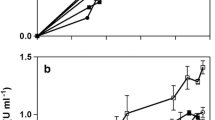Summary
In our laboratory, EAPc-7 a strain having higher aspartase activity was derived from Escherichia coli ATCC 11303. For the improvement of l-aspartic acid productivity using EAPc-7 cells immobilized in χ-carrageenan, it was necessary to eliminate the fumarase activity which converts fumaric acid to l-malic acid. Several treatments for specifically eliminating fumarase activity from EAPc-7 cells were tested and it was found that when EAPc-7 cells were treated in a culture broth (pH 4.9) containing 50 mM l-aspartic acid at 45° C for 1 h, fumarase activity was almost completely eliminated without inactivation of the aspartase.
The treated cells, immobilized in χ-carrageenan, were used for continuous production of l-aspartic acid from ammonium fumarate. The formation of l-malic acid was negligible and the half-life of the immobilized preparation was 126 days.
Productivity of immobilized preparation of treated EAPc-7 cells in l-aspartic acid production was six times of that of the parent cell preparation.
Similar content being viewed by others
References
Chibata I, Tosa T, Sato T (1974) Immobilized aspartase-containing microbial cells: preparation and enzymatic properties. Appl Microbiol 27:878–885
Goodman AE, Stark JB (1957) Rapid method for determination of malic acid. Anal Chem 29:283–287
Henderson LM, Snell EE (1948) A uniform medium for determination of amino acids with various microorganisms. J Biol Chem 172:15–29
Nishida Y, Sato T, Tosa T, Chibata I (1979) Immobilization of Escherichia coli cells having aspartase activity with carrageenan and locust bean gum. Enzyme Microbiol Technol 1:95–99
Nishimura N, Kisumi M (1984) Aspartase-hyperproducing mutants of Escherichia coli B. Appl Environ Microbiol (in press)
Sato T, Nishida Y, Tosa T, Chibata I (1979) Immobilization of Escherichia coli cells containing aspartase activity with χ-carrageenan: enzymic properties and application for l-aspartic acid production. Biochim Biophys Acta 570:179–186
Takamatsu S, Umemura I, Yamamoto K, Sato T, Tosa T, Chibata I (1982) Production of l-alanine from ammonium fumarate using two immobilized microorganisms. Eur J Appl Microbiol Biotechnol 15:147–152
Takata I, Yamamoto K, Tosa T, Chibata I (1980) Immobilization of Brevibacterium flavum with carrageenan and its application for continuous production of l-malic acid. Enzyme Microbiol Technol 2:30–36
Tosa T, Sato T, Mori T, Chibata I (1974) Basic studies for continuous production of l-aspartic acid by immobilized Escherichia coli cells. Appl Microbiol 27:886–889
Author information
Authors and Affiliations
Rights and permissions
About this article
Cite this article
Umemura, I., Takamatsu, S., Sato, T. et al. Improvement of production of l-aspartic acid using immobilized microbial cells. Appl Microbiol Biotechnol 20, 291–295 (1984). https://doi.org/10.1007/BF00270588
Received:
Issue Date:
DOI: https://doi.org/10.1007/BF00270588




